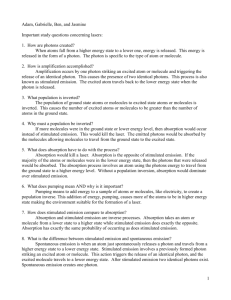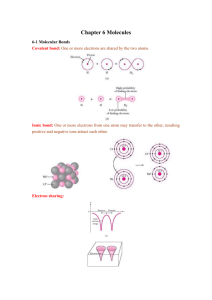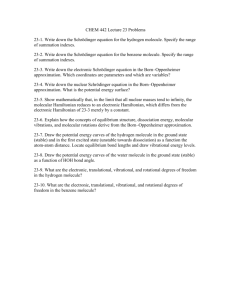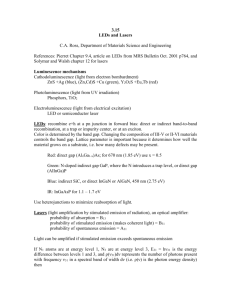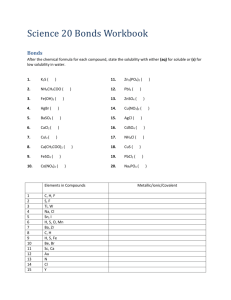LASER Spectroscopy
advertisement
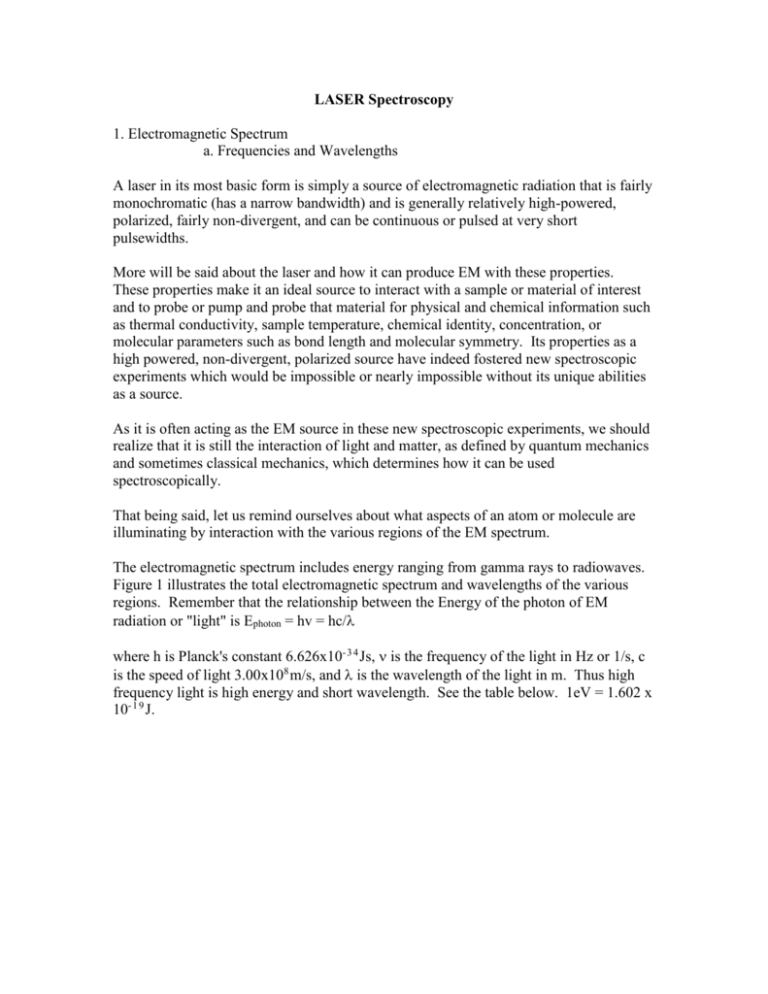
LASER Spectroscopy 1. Electromagnetic Spectrum a. Frequencies and Wavelengths A laser in its most basic form is simply a source of electromagnetic radiation that is fairly monochromatic (has a narrow bandwidth) and is generally relatively high-powered, polarized, fairly non-divergent, and can be continuous or pulsed at very short pulsewidths. More will be said about the laser and how it can produce EM with these properties. These properties make it an ideal source to interact with a sample or material of interest and to probe or pump and probe that material for physical and chemical information such as thermal conductivity, sample temperature, chemical identity, concentration, or molecular parameters such as bond length and molecular symmetry. Its properties as a high powered, non-divergent, polarized source have indeed fostered new spectroscopic experiments which would be impossible or nearly impossible without its unique abilities as a source. As it is often acting as the EM source in these new spectroscopic experiments, we should realize that it is still the interaction of light and matter, as defined by quantum mechanics and sometimes classical mechanics, which determines how it can be used spectroscopically. That being said, let us remind ourselves about what aspects of an atom or molecule are illuminating by interaction with the various regions of the EM spectrum. The electromagnetic spectrum includes energy ranging from gamma rays to radiowaves. Figure 1 illustrates the total electromagnetic spectrum and wavelengths of the various regions. Remember that the relationship between the Energy of the photon of EM radiation or "light" is Ephoton = hv = hc/ where h is Planck's constant 6.626x10- 3 4 Js, is the frequency of the light in Hz or 1/s, c is the speed of light 3.00x108 m/s, and is the wavelength of the light in m. Thus high frequency light is high energy and short wavelength. See the table below. 1eV = 1.602 x 10- 1 9 J. Figure 1. Electromagnetic Spectrum The primary wavelengths of laser radiation for current military and commercial applications include the ultraviolet, visible, and infrared regions of the spectrum. Ultraviolet radiation for lasers consists of wavelengths between 180 and 400 nm. The visible region consists of radiation with wavelengths between 400 and 700 nm. This is the portion we call visible light. The infrared region of the spectrum consists of radiation with wavelengths between 700 nm and 1 mm. Laser radiation absorbed by the skin penetrates only a few layers. In the eye, visible and near infrared radiation passes through the cornea, and is focused on and absorbed by the retina. It is the wavelength of the light that determines the visible sensation of color: violet at 400 nm, red at 700 nm, and the other colors of the visible spectrum in between. Spectroscopically speaking, we are interested in gaining information about the molecule or system by probing it with a source of EM radiation (a LASER). So what parts of the molecule are probed by the interaction of matter and energy in the different regions of the electromagnetic spectrum? This interaction is largely governed by the conservation of energy and conservation of momentum. Let us remind ourselves then about the energy levels that exist in a molecule and how they are related to one another, energetically speaking. b. Transitions involving absorption of photon from region of the EM. Light interacts with matter through primarily two processes, scattering and absorption. Light has energy associated with it, so if it is absorbed by a compound or some material in general, then the energy of the material that absorbs the photons of light, must increase by the amount of energy per photon times the total number of photons absorbed. This is just conservation of energy. In scattering, the photon of light is not directly absorbed by the material but still may alter the energy of the material if it is not elastically scattered. If a photon is to be absorbed, then the energy difference between the molecule in its final state after absorbing the photon and its initial state, before absorbing the photon, must be equal to the energy of the photon of light. Since the various regions of the electromagnetic spectrum have different wavelengths and different energies, the different regions of electromagnetic spectrum must probe different energy state of the molecule. What types of energy are associated with an atom or a molecule. In an atom, electrons can be in a ground state configuration or in an excited state configuration. In some cases, the ground state is one where all the electrons are spin paired and this is referred to by its multiplicity and called a singlet state, or if the electrons are not paired then the multiplicity may be doublet or triplet etc, depending upon how many electrons are unpaired. The multiplicity goes as 2s+1. Atoms are also moving in space and therefore have energy states related to their kinetic energy of movement. Molecules also have ground and excited electronic energy states depending on how the electrons are arranged in the molecule. The two lowest electronic states are often referred to as the HOMO, the ground state Highest Occupied Molecular Orbital, and the lowest energy excited state, the LUMO, lowest unoccupied molecular orbital. As in the case of atoms, molecules also move through space and have energy associated with the kinetic energy of movement of the whole molecule. But unlike atoms, molecules have two other types of energy associated with movement associated with vibrations of the atoms with the molecule and also rotations of the molecule in space. Additionally in atoms and molecules, the nucleus or nuclei have a nuclear spin associated with them, and there are ground and excited nuclear spin states as well. Do transitions between the different types or energy levels: electronic, vibrational, rotational, translational, nuclear spin absorb the same type of photon. If we plot several of these energy types on the same energy diagram then we can see the differences in energy corresponding to the different types of molecular energy. The potential energy well is often harmonic near the bottom of the well but does not remain so near the top of the well. This means that the energy spacing between the vibrational states grow closer together. Note also that there are several excited states and some of the excited states are bound and others are dissociative. Energy Diagram for Diatomic Molecule dissociative electronic state vibrational state electronic state vibrational state electronic state vibrational state Energy vibrational state vibrational state rotational state rotational state vibrational state electronic state internuclear distance Based on the digram an energy transition between two electronic states has the highest energy and is associated with when UV-Visible light is absorbed or emitted, IR light is absorbed or emitted when a molecule makes a transition between two vibrational states, microwave light is absorbed or emitted when a molecule makes a transition between two rotational states. If one is using a MASER as a source, it is likely that the pure rotational energy levels are being probed. If one is using an infrared laser as a source, it is likely that the vibrational energy levels are the target of our interest. And, if we use a visible laser as the source in our experiment, it is likely that we are probing the electronic energy levels of the molecule (but not always, what else could it be?) 2. Interaction of Light and Matter (Absorption and Scattering) a. Absorption a. Einstein A and B coefficients Einstein said three ways for transitions to occur between states! Stimulated Absorption “B” Transition from a low energy state to one of higher energy that is driven by the electromagnetic field oscillating at a frequency that matches the transition energy between the two states according to Etransition = hphoton Einstein wrote the per molecule transition rate, w, from a lower to upper state is w=B where d is the energy density of radiation in the frequency range from to d, and is the frequency of the transition. For instance if the molecule was exposed to blackbody radiation from a source at Temp T, then is given by the Planck distribution = (8h3 /c3 ) / (eh v / k T -1) B is known as the Einstein coefficient of stimulated Absorption and can be thought of as an empirical parameter that characterizes the transition. If B is large, then a given intensity of incident radiation with induce transitions strongly and the sample wil be strongly absorbing. More about B below. The total rate of absorption W = Nlower w, where Nlower is the number of molecules in the lower energy state. Under equilibrium conditions the relative population of the lower and upper state is given by the Boltzmann distribution Nupper / Nlower = gupper / g lower exp[-(Eupper - Elower) / kT ] where g is the degeneracy of the state, k is Boltzmann's constant and T is the temperature of the sample. Stimulated Emission “B'” Einstein also realized that the radiation was also able to induce the molecule in an upper state to undergo a transition to a lower energy state, and in the process generate or EMIT a photon of frequency v, again where Etransition = hphoton. The rate of this stimulated emission is given by: w' = B' where B' is the coefficient of stimulated emission. NOTE that ONLY radiation of the frequency corresponding to the transition energy is able to stimulate an excited state to fall to a lower state. Spontaneous Emission “A” Einstein further realized that in addition to a molecule being stimulated to fall to a lower energy state, a molecule in an excited state would spontaneously fall from a higher to a lower energy state. That is a molecule in an excited state could undergo spontaneous emission at a rate that did not depend upon the presence or intensity of an electromagnetic field so w' = A for spontaneous emission where A is the Einstein coefficient of spontaneous emission THUS the TOTAL per molecule transition rate from a molecule in a excited state to a lower energy state is w' = A + B' And if there are Nupper molecules in the excited state, the overall rate for Nupper molecules is W' = Nupper(A + B') One can show using Boltzmann's Law that B = B' and that the spontaneous coefficient is related to B by: A = (8htrans3 / c3 ) B Note that the importance of the contribution to the overall rate of emission by spontaneous emission gets much larger with increasing frequency. So the spontaneous transition rate from an excited electronic state to a lower electronic energy state is much higher than a transition from an excited vibrational or rotational state to a lower vibrational or rotational energy state. Also, the equality of the coefficients of stimulated emission and stimulated absorption implies that if the two states happen to have equal populations, then the rate of stimulated emission is equal to the rate of stimulated absorption and there will be no net absorption or no net emission. If there are more molecules in the lower energy state then there can be a net absorption, and if there are more molecules in the excited state then there can be a net emission. Thus one requirement for laser action is to have the net stimulated emission being larger than the stimulated absorption, so somehow the laser system has to promote the existence of a population inversion. That is a true laser must have more molecules in an excited state than there are in the ground state, in order to have a significant stimulated emission process. (ONE TRUISM TO KEEP IN MIND IS THAT EXCITATION TO AND EXCITED STATE OR LOSS OF ENERGY FROM AN EXCITED STATE IS NOT ALWAYS STRICTLY ALLOWED. THERE ARE SELECTION RULES
